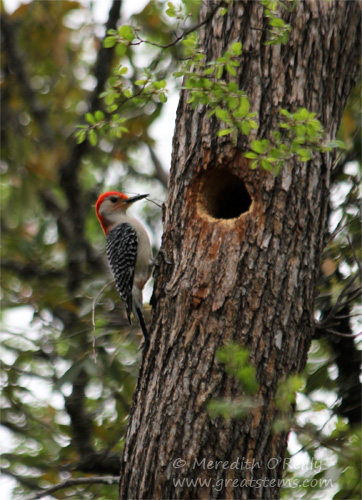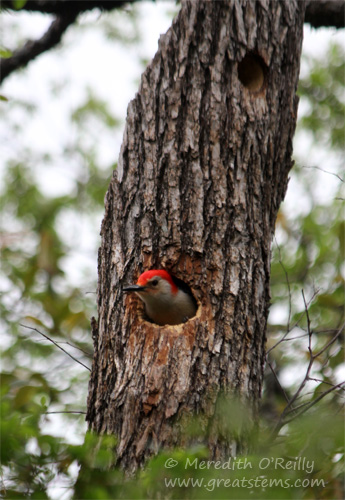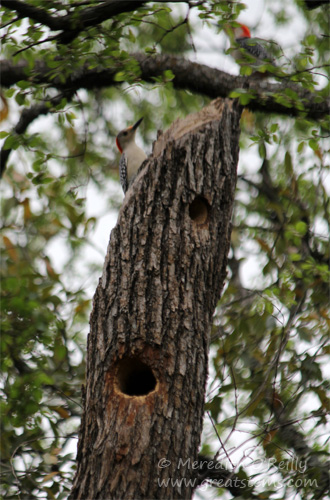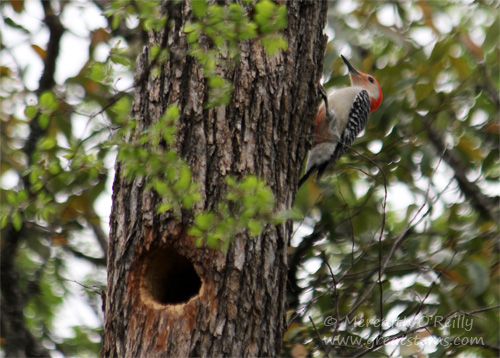Why, hello, Spring! Between holidays, work, presentations, and a slight obsession with chickens, I’ve woefully neglected my blog. But ever does the wildlife habitat continue. I thought I’d venture back to blogging with our newest family in the making — a pair of Red-Bellied Woodpeckers are working on their nest in a dead tree behind our fence, happily situated so we can manage to watch them from our yard.
 Here is the male. He frequents our birdfeeder, which we keep amply supplied with peanuts for him. Well, he does have to share with other visiting woodpeckers, blue jays, and other feathered friends who also love peanuts. That was the deal we made.
Here is the male. He frequents our birdfeeder, which we keep amply supplied with peanuts for him. Well, he does have to share with other visiting woodpeckers, blue jays, and other feathered friends who also love peanuts. That was the deal we made.
The female is rather shy and elusive, but I managed to capture her (along with her partner) in the image above. While males have red across their head from the bill to the nape, females have red on their nape only.
 It’s hard to tell whether the birds are actually nesting right now or still excavating their cavity, but if the latter, they’ve been working on it a long time. I do know they are working hard.
It’s hard to tell whether the birds are actually nesting right now or still excavating their cavity, but if the latter, they’ve been working on it a long time. I do know they are working hard.
In this image (above), you can see the blushing belly that gives Red-bellied Woodpeckers their name. It’s a common mistake for people to call them Red-headed instead of Red-bellied, but Red-headed Woodpeckers are another species entirely and have red feathers over their whole head, not just in faux-hawk fashion.
Along with their vast assistance in controlling insect populations, the fact that Red-bellied Woodpeckers make nesting cavities like this is very important in nature. Abandoned cavities become potential homes for other cavity-nesting animal species, such as Screech Owls, Bluebirds, Wrens, Chickadees, Nuthatches, and small mammals. On the other hand, invasive European Starlings, who also use cavities, are a threat to any native species in a cavity, because the Starlings often don’t hesitate to kill adults or young inside the nests in order to gain occupancy. I’m hopeful that our Red-bellied family will be safe, though.
We’ll stay on the lookout for signs of young in hopes of sharing an update in the near future.


We found this lovely woodpecker frequenting our trees and the suet feeder this winter. I hope to see more of them and that they might build a nest close by or even in the garden. Great captures!
Welcome back to blogging! And with such a delightful and informative post. The woodpeckers are active here, too, along with many other species. The juncos are still hanging out, as well, and I’d just as soon see them leave and head north for the season. 😉 Great photos, as always, Meredith!
These wonderful birds’ funny call is so distinctive it’s hard to mistake for anything else, and I’ve taught all of my neighbors to listen for them. So grateful for the large population we somehow have in my neck of the no-woods.
Love the woodpeckers. This winter and spring, the red bellies have been visiting the suet feeder (I think the red bellies caught on to the fact that the Downeys weren’t having to work as hard for their food). Unfortunately, the starlings, grackles, and I think now the squirrels have also figured out that the suet is usually out for the woodpeckers. sigh. guess I ought to invest in some of the hot pepper suet to at least take care of the squirrels.
One of these beautiful birds was visiting the birdbath a little while ago – love seeing the fauxhawk in my garden as well as on your blog. Great post!
Annie at the Transplantable Rose